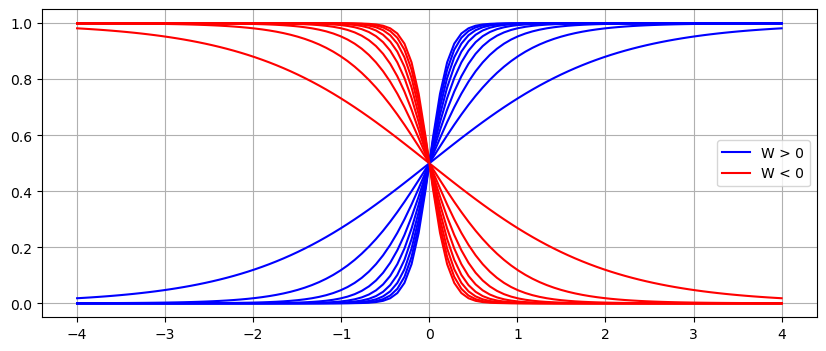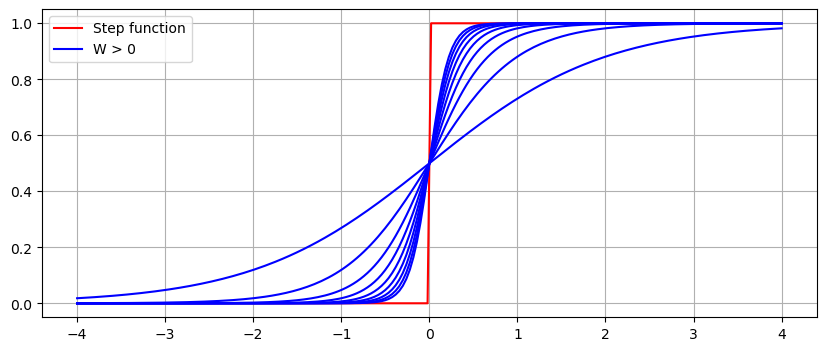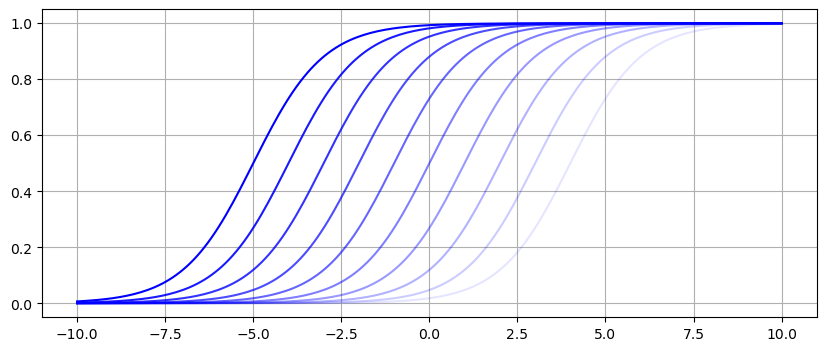Logistic Function#
import numpy as np
import matplotlib.pyplot as plt
Definition and Properties#
The logistic function is \(\sigma(x) = \displaystyle \frac{1}{1 + e^{-x}}\). Plot the logistic function over the interval \([-10,10]\).
x = np.linspace(-10,10,100)
y = 1/(1 + np.exp(-x))
plt.figure(figsize=(8,2))
plt.plot(x,y,'b'), plt.grid(True)
plt.show()

The \(y\)-intercept is
We can see that \(0 < \sigma(x) < 1\) for all \(x\) and the limits at infinity are
Compute the derivative
The function \(\sigma(x)\) satisfies the differential equation \(\sigma' = \sigma(1 - \sigma)\) since
The slope at the \(y\)-intercept is
The limits at infinity of the derivative are
Weight and Bias Parameters#
The logistic function with weight \(W\) and bias \(b\) is
How does \(W\) change the graph of the logistic function? Let \(b=0\) and plot \(\sigma(x; W,0)\) for many different values of \(W\).
x = np.linspace(-4,4,100)
N = 10
plt.figure(figsize=(10,4))
for W in np.arange(1,N):
y = 1/(1 + np.exp(-W*x))
plt.plot(x,y,'b')
y = 1/(1 + np.exp(W*x))
plt.plot(x,y,'r')
plt.grid(True)
plt.legend(['W > 0','W < 0'])
plt.show()

As \(W \to \infty\), the function \(\sigma(x; W,0)\) approaches the function
Use the function np.heaviside to plot the step function along with \(\sigma(x; W, 0)\) for several positive weight values \(W > 0\).
x = np.linspace(-4,4,200)
y = np.heaviside(x,1)
plt.figure(figsize=(10,4))
plt.plot(x,y,'r')
for W in np.arange(1,10):
y = 1/(1 + np.exp(-W*x))
plt.plot(x,y,'b')
plt.legend(['Step function','W > 0'])
plt.grid(True)
plt.show()

Similarly, as \(W \to -\infty\), the function \(\sigma(x; W,0)\) approaches the function
How does \(b\) change the graph of the logistic function? Let \(W=1\) and plot \(\sigma(x;1,b)\) for many different values of \(b\).
N = 5
W = 1
x = N*np.linspace(-2,2,200)
plt.figure(figsize=(10,4))
for b in np.arange(-N,N+1):
y = 1/(1 + np.exp(-(W*x + b)))
plt.plot(x,y,'b',alpha=(b + N)/N/2)
plt.grid(True)
plt.show()

The bias parameters shifts the graph to the left by \(b/W\) since
See also
Check out Wikipedia: Logistic Function for more information.
